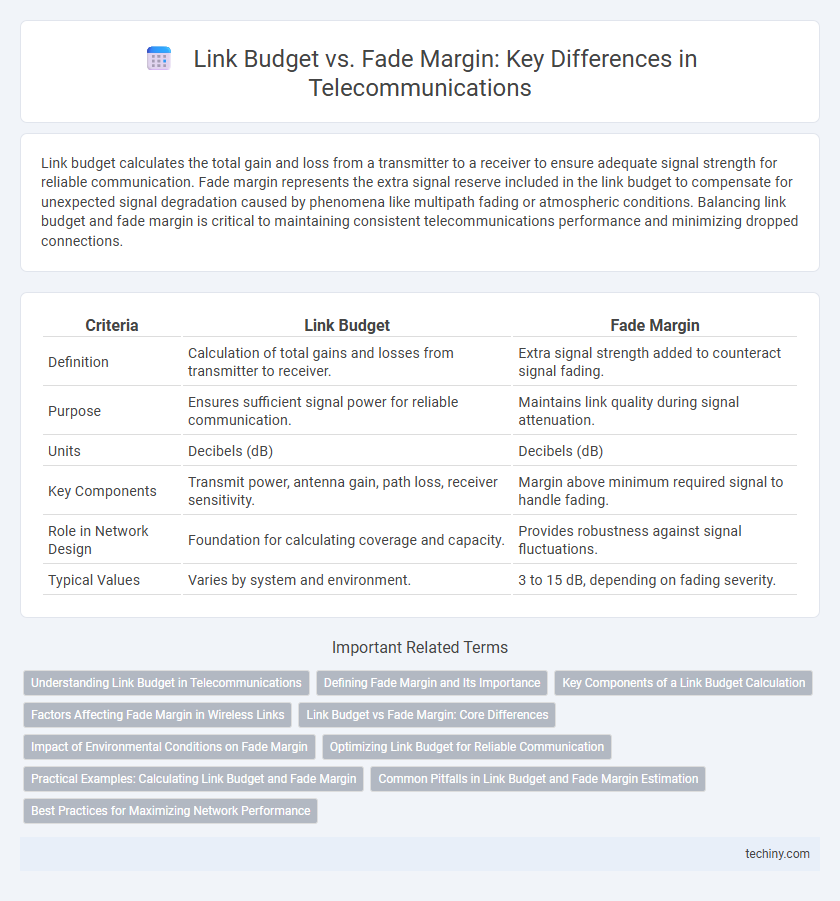Link budget calculates the total gain and loss from a transmitter to a receiver to ensure adequate signal strength for reliable communication. Fade margin represents the extra signal reserve included in the link budget to compensate for unexpected signal degradation caused by phenomena like multipath fading or atmospheric conditions. Balancing link budget and fade margin is critical to maintaining consistent telecommunications performance and minimizing dropped connections.
Table of Comparison
| Criteria | Link Budget | Fade Margin |
|---|---|---|
| Definition | Calculation of total gains and losses from transmitter to receiver. | Extra signal strength added to counteract signal fading. |
| Purpose | Ensures sufficient signal power for reliable communication. | Maintains link quality during signal attenuation. |
| Units | Decibels (dB) | Decibels (dB) |
| Key Components | Transmit power, antenna gain, path loss, receiver sensitivity. | Margin above minimum required signal to handle fading. |
| Role in Network Design | Foundation for calculating coverage and capacity. | Provides robustness against signal fluctuations. |
| Typical Values | Varies by system and environment. | 3 to 15 dB, depending on fading severity. |
Understanding Link Budget in Telecommunications
Link budget in telecommunications quantifies the total gain and loss from a transmitter to a receiver, ensuring signal strength meets system requirements. It incorporates factors such as transmitter power, antenna gains, path loss, and receiver sensitivity. Accurate link budget calculations are critical for designing reliable communication links and optimizing coverage areas.
Defining Fade Margin and Its Importance
Fade margin is the additional signal strength included in a link budget to compensate for signal degradation caused by obstacles, weather, or interference during transmission. It ensures a reliable telecommunications connection by maintaining signal quality above the receiver sensitivity threshold despite fading. Properly calculated fade margin is critical for optimizing network performance, minimizing outages, and maximizing coverage area.
Key Components of a Link Budget Calculation
Key components of a link budget calculation include transmitter power, antenna gains for both transmitter and receiver, path loss over the transmission distance, and system losses such as cabling and connector losses. Fade margin represents the extra signal level added to the link budget to ensure reliable communication despite signal fading caused by environmental factors like multipath propagation and atmospheric conditions. Accurate estimation of path loss models and incorporation of fade margin are crucial for designing robust telecommunications links with desired quality of service.
Factors Affecting Fade Margin in Wireless Links
Fade margin in wireless links is influenced by factors such as signal frequency, environmental conditions, and antenna characteristics. Higher frequencies suffer more from atmospheric absorption and multipath fading, requiring greater fade margins. Physical obstacles, weather variations like rain or fog, and antenna gain or alignment also critically affect the reliability and required fade margin in the link budget.
Link Budget vs Fade Margin: Core Differences
Link budget quantifies the total gain and loss from the transmitter to the receiver, determining the overall signal strength available for communication. Fade margin represents the extra signal power allocated beyond the minimum required to maintain reliable connectivity during signal fading or degradation caused by environmental factors. The core difference lies in link budget being a comprehensive calculation of expected signal levels, while fade margin acts as a safety buffer to ensure consistent performance under variable conditions.
Impact of Environmental Conditions on Fade Margin
Environmental conditions such as rain, fog, and atmospheric turbulence significantly affect the fade margin in telecommunications by increasing signal attenuation and causing multipath fading. Properly accounting for these factors in the link budget ensures sufficient fade margin to maintain reliable communication and minimize signal degradation. Fade margin must be optimized based on regional climate data and weather variability to enhance link stability and performance.
Optimizing Link Budget for Reliable Communication
Optimizing link budget involves accurately calculating transmitter power, antenna gains, path loss, and receiver sensitivity to ensure sufficient signal strength at the destination. Fade margin is incorporated as a buffer to counteract unpredictable signal attenuation due to environmental factors like weather or obstacles. Effective management of fade margin within the link budget enhances communication reliability by maintaining signal quality during fading conditions.
Practical Examples: Calculating Link Budget and Fade Margin
Calculating a link budget involves summing the transmitter power, antenna gains, and subtracting losses such as free-space path loss and system impairments to determine the received signal strength in a telecommunications link. A practical example includes a 20 dBm transmitter power, 15 dBi antenna gains on both ends, and a 100-meter free-space path loss, resulting in a received power of approximately 10 dBm. Fade margin is then calculated by subtracting the minimum required received signal level (sensitivity) from the actual received power, ensuring reliable performance amid signal variations, such as a 10 dB fade margin with a receiver sensitivity of 0 dBm.
Common Pitfalls in Link Budget and Fade Margin Estimation
Common pitfalls in link budget and fade margin estimation include underestimating environmental factors such as multipath fading, terrain obstructions, and weather conditions that degrade signal strength. Inaccurate assumptions about antenna gains, cable losses, and transmitter power levels lead to erroneous budget calculations, compromising network reliability. Failure to incorporate sufficient fade margin results in increased outage risk during adverse conditions, emphasizing the need for realistic, site-specific measurements and conservative design margins.
Best Practices for Maximizing Network Performance
Optimizing link budget calculations involves precisely accounting for all gains and losses in a communication path to ensure sufficient signal strength at the receiver. Incorporating an adequate fade margin, typically between 10 to 20 dB depending on environmental variability and service requirements, helps counteract signal degradation due to fading and interference. Regularly updating these parameters based on real-time measurements and propagation models enhances network reliability and maximizes overall telecommunications performance.
Link Budget vs Fade Margin Infographic

 techiny.com
techiny.com